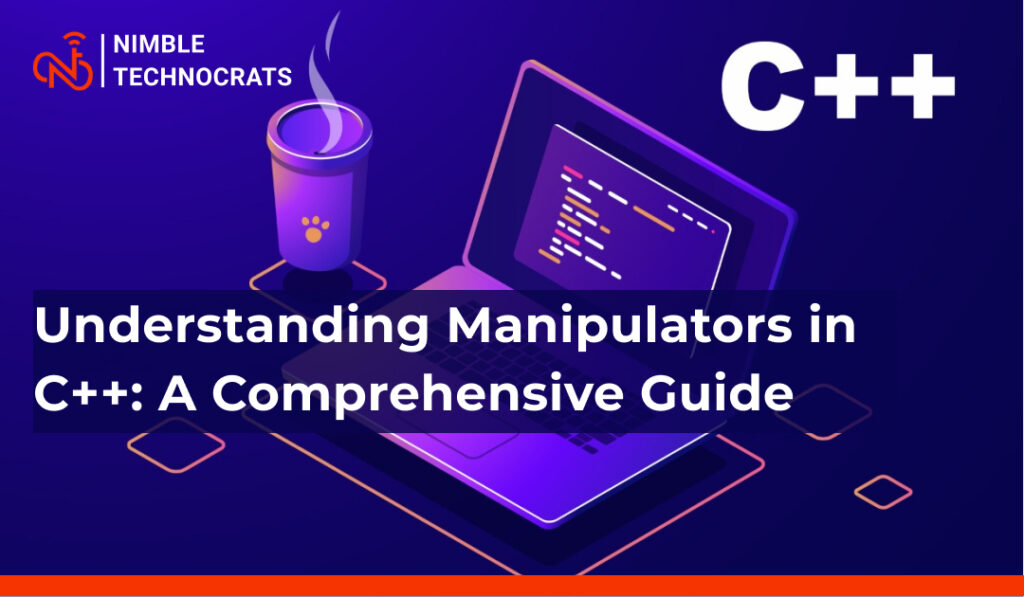Understanding Manipulators in C++: A Comprehensive Guide
If you want to improve your C++ programming skills, irrespective of whether you are an experienced programmer or a beginner, you must have knowledge regarding manipulators in C++. To know what these are, stick to this blog.
What are Manipulators in C++?
In C++ programming language, manipulators help in improving the aesthetics of output formatting. They are powerful functions used by developers to control several factors of how data is displayed on the screen or in files.
To change the output behaviour of standard stream objects, such as ‘cin’ and ‘cout’, C++ manipulators are used. They are used to change the data formatting, including field width, alignment, precision, padding, and more. They can be applied to the output stream using the insertion operator (<<) to change the subsequent output’s formatting. Thus, this is the manipulator definition in C++.
Manipulators in C++ in Hindi
मानक स्ट्रीम ऑब्जेक्ट्स, जैसे ‘सिन’ और ‘काउट’ के आउटपुट व्यवहार को बदलने के लिए, C++ मैनिपुलेटर्स का उपयोग किया जाता है। उनका उपयोग डेटा फ़ॉर्मेटिंग को बदलने के लिए किया जाता है, जिसमें फ़ील्ड चौड़ाई, संरेखण, परिशुद्धता, पैडिंग और बहुत कुछ शामिल है। बाद के आउटपुट के स्वरूपण को बदलने के लिए इन्हें इंसर्शन ऑपरेटर (<<) का उपयोग करके आउटपुट स्ट्रीम पर लागू किया जा सकता है।
Why are they Used?
In C++, manipulators offer a practical method to manage output formatting, making it more understandable and aesthetically pleasing. Data can be presented consistently across many platforms and systems thanks to manipulators. Additionally, they help with accuracy control, base representation of numbers, data alignment in columns, and many other tasks. Moreover, if you want to learn a programming language, then you can reach out to top IT companies in Jalandhar, where there are various trainers who can help you learn the programming language.
What is a Manipulator and Its types?
C++ has a wide range of manipulators to match different formatting requirements. The most common types of manipulators include:
`std::setw(n)`: It is used to set the field width to n characters.
`std::setprecision(n)`: It sets the precision (number of decimal places) to n.
`std::fixed`: It forces decimal representation for floating-point numbers.
`std::scientific`: Forces scientific notation for floating-point numbers.
`std::setfill(c)`: Sets the fill character to c for padding.
Now, take a look at the following used manipulators in C++ program:
#include <iostream>
#include <iomanip>
using namespace std;
int main()
{
float PI = 3.14;
int num = 100;
cout << “Enter a new line.” << endl;
cout << setw(15) << “Output” << endl;
cout << setprecision(10) << PI << endl;
cout << setbase(16) << num << endl; //sets base to 16
}
OUTPUT
Enter a new line.
Output
3.140000105
64
What is the Use of SETW Manipulator in C++?
In C++, setw function is a manipulator that stands for set width. This is used to set the ios library field width or mention the minimum number of character positions a variable will use. In simple words, the setw manipulator in C++ helps set the width of the field for output operations. The function takes a number as an argument and requires a stream where this field needs to be manipulated. The following is the syntax of setw manipulator in C++:
setw(int number)
What Type of Manipulator is Endl?
The Endl in C++ is a manipulator function used to change the input and output stream in C++. Basically, the manipulators are used for data formatting that is shown to the user and used with insertion (<<) and extraction (>>) operators.
What are Manipulators in Java?
You can use string manipulation in Java. There are four string manipulation functions in Java that include: substring (), toLowerCase (), trim (), and toUpperCase (). Using these functions, you can perform different types of string manipulators in Java, including the removal of white spaces, character case conversion, and substring extraction.
Example:
public class Main
{public static void main(String[] args) {
String original = ” Hello World!”;
System.out.println(original);
System.out.println(original.trim());
System.out.println(original.toLowerCase());
System.out.println(original.toUpperCase());
}
}
Output:
Hello World!
Hello World!
hello world!
HELLO WORLD!
Conclusion
By using the power of manipulators, developers can improve the structure of the output of the code. You can get training in programming languages from Nimble Technocrats. Apart from programming, you can also learn SEO as it is considered the best SEO Company in Punjab.
Other Useful link:-
Understanding Manipulators in C++: A Comprehensive Guide Read More »
